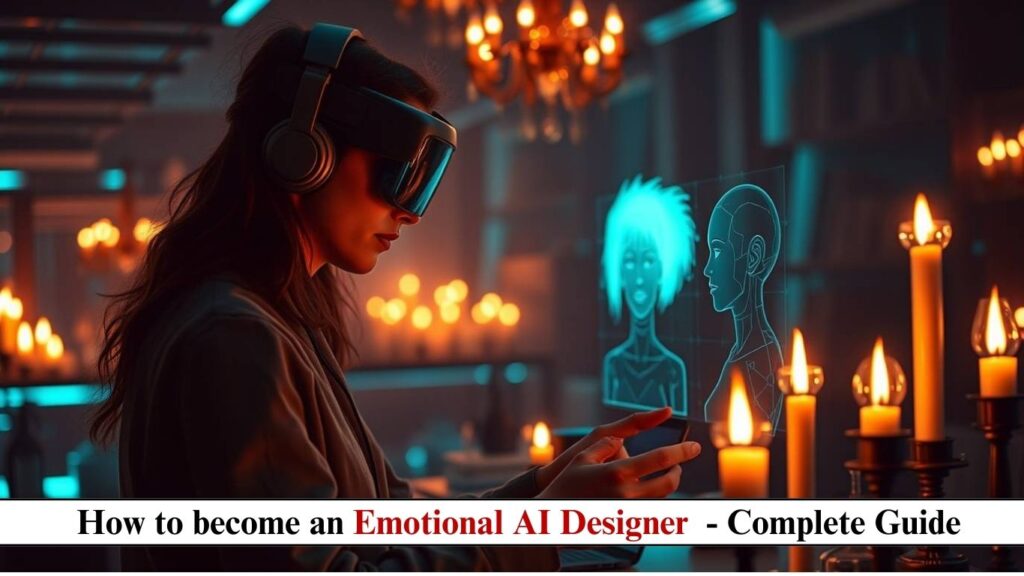
Introduction to Emotional AI (Affective Computing)
Emotional AI, also known as Affective Computing, is revolutionizing how machines understand and respond to human emotions. An Emotional AI Designer develops systems that detect, interpret, and simulate human emotions—transforming industries from healthcare to marketing.
This comprehensive guide covers:
✔ History of Emotional AI
✔ Salary expectations & career growth
✔ Roles & responsibilities
✔ Required qualifications & skills
✔ How to get started
✔ Future trends & opportunities
History of Emotional AI
The journey of machines understanding emotions spans decades.
Key Milestones in Emotional AI:
- 1995: MIT’s Rosalind Picard coins the term “Affective Computing”
- 2000s: Early emotion recognition via facial analysis (FaceReader)
- 2010s: Voice-based emotion detection (Beyond Verbal, Affectiva)
- 2016: AI chatbots (Replika) simulate empathetic conversations
- 2020s: Multimodal emotion AI (combining voice, face, biometrics)
- 2024: GPT-4 integrates tone analysis for emotional responses
Today, Emotional AI powers mental health apps, customer service bots, and immersive gaming.
Emotional AI Designer Salary
Salaries vary by expertise, industry, and location.
Average Salary Ranges (Annual):
| Experience Level | Salary Range |
|---|---|
| Entry-Level (0-2 yrs) | $80,000 – $120,000 |
| Mid-Level (3-5 yrs) | $120,000 – $180,000 |
| Senior-Level (5+ yrs) | $180,000 – $250,000+ |
Top-Paying Industries:
- Healthcare (Therapy Bots, Diagnostics) – $140K-$220K
- Marketing & Customer Experience – $130K-$200K
- Gaming & VR (Emotion-Driven NPCs) – $110K-$180K
- Defense (Stress Detection for Soldiers) – $150K-$230K
Freelance consultants charge $100-$400/hour for niche projects.
Roles & Responsibilities
Emotional AI designers blend psychology, AI, and UX design.
Core Responsibilities:
- Emotion Detection Systems
- Develop models to analyze:
✔ Facial expressions (OpenCV, DeepFace)
✔ Voice tone (Librosa, OpenAI Whisper)
✔ Biometrics (heart rate, EEG)
- Develop models to analyze:
- AI Response Design
- Program empathetic chatbot responses (GPT-4, Rasa)
- Create adaptive gaming NPCs that react to player emotions
- Ethical AI Frameworks
- Ensure privacy-first emotion data collection
- Mitigate bias in emotion recognition (e.g., cross-cultural facial expressions)
- User Experience (UX) Integration
- Design interfaces that adjust based on user mood
- Example: Calm app’s breathing coach that adapts to stress levels
Qualifications & Skills Needed
A hybrid skillset of tech, psychology, and ethics is essential.
Education & Certifications:
- Degrees in:
- Computer Science (AI/ML focus)
- Cognitive Psychology / Neuroscience
- Human-Computer Interaction (HCI)
- Certifications:
- Affective Computing Specialization (MIT OpenCourseWare)
- Emotion AI Certification (Affectiva Academy)
Technical Skills:
✔ Machine Learning: Python (PyTorch, TensorFlow), emotion datasets (AffWild2)
✔ Multimodal Analysis: Combining voice, face, and text data
✔ UX/UI Design: Figma, Adobe XD for emotion-aware interfaces
Soft Skills:
✔ Empathy to design authentic emotional responses
✔ Critical thinking to address AI bias
✔ Cross-disciplinary collaboration
How to Get Started in Emotional AI
Step 1: Learn the Fundamentals
- Free courses:
- Affective Computing on edX
- Emotion Recognition with Python (Udemy)
- Read: “Atlas of the Heart” by Brené Brown (emotion taxonomy)
Step 2: Experiment with Tools
- Open-Source Libraries:
- OpenFace (facial emotion analysis)
- EmoPy (Python emotion detection)
- APIs: Affectiva, Hume AI
Step 3: Build a Portfolio
- Projects to showcase:
- A chatbot that adapts to user sentiment
- A game NPC that reacts to player frustration
Step 4: Gain Experience
- Intern at AI ethics labs or mental health tech startups
- Contribute to GitHub emotion AI projects
Step 5: Specialize & Network
- Niches:
- Healthcare: PTSD therapy bots
- Retail: Emotion-driven ad targeting
- Join communities: Affective Computing Slack, IEEE Emotion AI group
Future of Emotional AI
The next decade will see emotion-aware AI everywhere.
Emerging Trends:
- Wearable Emotion Tech
- Smartwatches detecting stress & depression biomarkers
- Education
- AI tutors that adapt to student frustration
- Metaverse
- Avatars mirroring real-time facial emotions
- Regulation
- Laws governing emotion data privacy (GDPR for feelings?)
Industries to Watch:
- Mental Health: AI therapists for 24/7 emotional support
- Automotive: Cars detecting driver road rage
- HR Tech: Interview bots assessing candidate emotional intelligence
Conclusion: Is Emotional AI Design Right for You?
If you’re passionate about AI, psychology, and ethical tech, this field offers high-impact, high-paying opportunities.
Your Next Steps:
- Master Python for emotion analysis
- Build a sentiment-aware chatbot
- Connect with affective computing researchers
The future of emotionally intelligent machines starts with designers like you. 🚀💡🤖













Post Comment